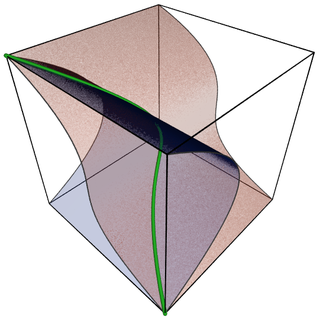
Differential geometry is a mathematical discipline that studies the geometry of smooth shapes and smooth spaces,otherwise known as smooth manifolds. It uses the techniques of differential calculus,integral calculus,linear algebra and multilinear algebra. The field has its origins in the study of spherical geometry as far back as antiquity. It also relates to astronomy,the geodesy of the Earth,and later the study of hyperbolic geometry by Lobachevsky. The simplest examples of smooth spaces are the plane and space curves and surfaces in the three-dimensional Euclidean space,and the study of these shapes formed the basis for development of modern differential geometry during the 18th and 19th centuries.
In mathematics,complex geometry is the study of geometric structures and constructions arising out of,or described by,the complex numbers. In particular,complex geometry is concerned with the study of spaces such as complex manifolds and complex algebraic varieties,functions of several complex variables,and holomorphic constructions such as holomorphic vector bundles and coherent sheaves. Application of transcendental methods to algebraic geometry falls in this category,together with more geometric aspects of complex analysis.
The Riemann–Roch theorem is an important theorem in mathematics,specifically in complex analysis and algebraic geometry,for the computation of the dimension of the space of meromorphic functions with prescribed zeros and allowed poles. It relates the complex analysis of a connected compact Riemann surface with the surface's purely topological genus g,in a way that can be carried over into purely algebraic settings.

Algebraic varieties are the central objects of study in algebraic geometry,a sub-field of mathematics. Classically,an algebraic variety is defined as the set of solutions of a system of polynomial equations over the real or complex numbers. Modern definitions generalize this concept in several different ways,while attempting to preserve the geometric intuition behind the original definition.
In mathematics,in particular algebraic geometry,a moduli space is a geometric space whose points represent algebro-geometric objects of some fixed kind,or isomorphism classes of such objects. Such spaces frequently arise as solutions to classification problems:If one can show that a collection of interesting objects can be given the structure of a geometric space,then one can parametrize such objects by introducing coordinates on the resulting space. In this context,the term "modulus" is used synonymously with "parameter";moduli spaces were first understood as spaces of parameters rather than as spaces of objects. A variant of moduli spaces is formal moduli. Bernhard Riemann first used the term "moduli" in 1857.
In mathematics,the Jacobian varietyJ(C) of a non-singular algebraic curve C of genus g is the moduli space of degree 0 line bundles. It is the connected component of the identity in the Picard group of C,hence an abelian variety.
In algebraic geometry,Brill–Noether theory,introduced by Alexander von Brill and Max Noether,is the study of special divisors,certain divisors on a curve C that determine more compatible functions than would be predicted. In classical language,special divisors move on the curve in a "larger than expected" linear system of divisors.
In mathematics,the tautological bundle is a vector bundle occurring over a Grassmannian in a natural tautological way:for a Grassmannian of -dimensional subspaces of ,given a point in the Grassmannian corresponding to a -dimensional vector subspace ,the fiber over is the subspace itself. In the case of projective space the tautological bundle is known as the tautological line bundle.
In mathematics,the Hitchin integrable system is an integrable system depending on the choice of a complex reductive group and a compact Riemann surface,introduced by Nigel Hitchin in 1987. It lies on the crossroads of algebraic geometry,the theory of Lie algebras and integrable system theory. It also plays an important role in the geometric Langlands correspondence over the field of complex numbers through conformal field theory.
In algebraic geometry,Lange's conjecture is a theorem about stability of vector bundles over curves,introduced by Herbet Lange and proved by Montserrat Teixidor i Bigas and Barbara Russo in 1999.
This is a glossary of algebraic geometry.
In differential geometry,algebraic geometry,and gauge theory,the Kobayashi–Hitchin correspondence relates stable vector bundles over a complex manifold to Einstein–Hermitian vector bundles. The correspondence is named after Shoshichi Kobayashi and Nigel Hitchin,who independently conjectured in the 1980s that the moduli spaces of stable vector bundles and Einstein–Hermitian vector bundles over a complex manifold were essentially the same.
In algebraic geometry,given a smooth projective curve X over a finite field and a smooth affine group scheme G over it,the moduli stack of principal bundles over X,denoted by ,is an algebraic stack given by:for any -algebra R,
Prakash Belkale is an Indian-American mathematician,specializing in algebraic geometry and representation theory.
This is a glossary of properties and concepts in symplectic geometry in mathematics. The terms listed here cover the occurrences of symplectic geometry both in topology as well as in algebraic geometry. The glossary also includes notions from Hamiltonian geometry,Poisson geometry and geometric quantization.
David Arends Gieseker is an American mathematician,specializing in algebraic geometry.
In algebraic geometry,a localized Chern class is a variant of a Chern class,that is defined for a chain complex of vector bundles as opposed to a single vector bundle. It was originally introduced in Fulton's intersection theory,as an algebraic counterpart of the similar construction in algebraic topology. The notion is used in particular in the Riemann–Roch-type theorem.
In mathematics,and in particular algebraic geometry,K-stability is an algebro-geometric stability condition for projective algebraic varieties and complex manifolds. K-stability is of particular importance for the case of Fano varieties,where it is the correct stability condition to allow the formation of moduli spaces,and where it precisely characterises the existence of Kähler–Einstein metrics.
In mathematics,and especially symplectic geometry,the Thomas–Yau conjecture asks for the existence of a stability condition,similar to those which appear in algebraic geometry,which guarantees the existence of a solution to the special Lagrangian equation inside a Hamiltonian isotopy class of Lagrangian submanifolds. In particular the conjecture contains two difficulties:first it asks what a suitable stability condition might be,and secondly if one can prove stability of an isotopy class if and only if it contains a special Lagrangian representative.






